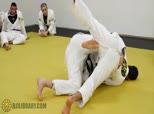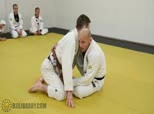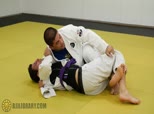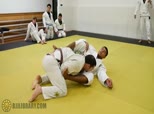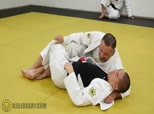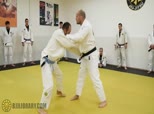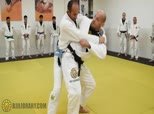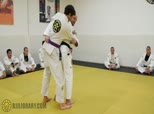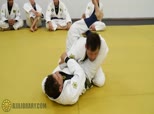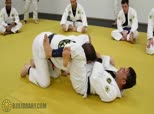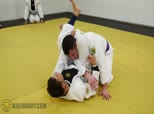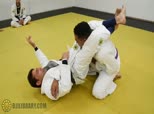Inside the University 659 - Staying Connected While Sweeping
Add to Favorites Remove From Favorites 567 2162 days ago
Xande touches on a few key details about staying connected, first off with your forehead. While setting up his sweep, he keeps his forehead connected to his opponent's body. While coming up to the top after sweeping, he keeps his forehead connected to the ground, which allows him the leverage he needs to get up. Another important detail is that his hook stays connected while sweeping, rather than trying to kick his opponent up and off his hook, which will not work against a resisting opponent.
Inside the University 658 - Butterfly Guard Hook Sweep
Add to Favorites 629 Remove From Favorites 2164 days ago
With his opponent on his knees, Xande sets up his butterfly guard with an underhook and his head on the opposite side of the body, always staying connected. Depending on whether his opponent posts his hand on the mat or on Xande's knee, Xande grabs the triceps or the wrist, and traps the arm to his body. Now he rolls to the side, staying tight with his hook and pushing off the mat with his free foot. Using the momentum, he comes to the top already in position to pass the guard.Inside the University 657 - Knee Slice Pass Variation from Half Guard
Add to Favorites 614 Remove From Favorites 2165 days ago
Now Gustavo Dias shows a guard pass he used on his way to double gold in Europe. From top in half guard, he reaches under the head and keeps heavy shoulder pressure on his opponent. He feeds the lapel to his hand to increase his control, and he grips the pants at the knee. While stretching the leg away from him, he frees his knee and raises his hips to turn and begin his knee slice pass. He keeps his head heavy across his opponent's body and frees his leg to establish side control.Inside the University 656 - Triangle from Butterfly Guard
Add to Favorites 622 Remove From Favorites 2166 days ago
Victor Hugo shows the triangle setup he used to finish his final fight. After pulling guard, he tries for a hook sweep, but his opponent keeps a heavy base and posts on Victor's knee. Victor grabs the wrist and pushes it in, and brings his bottom foot to the thigh and his top leg over the shoulder as he would for an omoplata. His opponent reacts by posturing up, so Victor throws his legs up and locks his feet to set up his triangle. Now he can bring the arm across and adjust the triangle to submit.Inside the University 655 - Back Step Half Guard Pass
Add to Favorites 500 Remove From Favorites 2167 days ago
Continuing the lessons from the champions at the Europeans, Professor Frank shows his half guard pass he used to win the final. While on top and failing to mount, Frank pulls out his opponent's lapel and feeds it behind the neck, making a strong cross face grip as he sits back into half guard. He slides his free leg in to block his opponent's hip, and grips his opponent's pants at the knee. Now he leans back a little, baiting his opponent to unlock his legs and bridge, giving Frank the opening he needs to back step his leg and gain side control.Inside the University 654 - O Goshi with Grip Over the Arm
Add to Favorites 596 Remove From Favorites 2168 days ago
In this scenario, which is what happened in Xande's fight, his opponent blocks his hip, preventing Xande from going under the arm and grabbing the belt. Instead, Xande reaches over the arm to make his grip. He also keeps heavy with his collar grip and uses a stiff arm to keep his opponent at bay if he tries to close the distance. Using the same fundamentals as the traditional o goshi, Xande steps in and tosses his opponent over his hip.Inside the University 653 - Creating the Angle to Throw
Add to Favorites 591 Remove From Favorites 2169 days ago
When Xande goes for the o goshi, he needs his opponent at the proper angle in order to throw him. He likes to set this up by sweeping at the foot and faking that he wants to throw him toward his back. His opponent reacts by stepping over Xande's foot and backing up. This gives Xande the space and angle he needs to step in and finish the throw.Inside the University 652 - Traditional O Goshi (Hip Toss) Takedown
Add to Favorites 547 Remove From Favorites 2170 days ago
Starting with the classic judo sleeve grip, Xande reaches behind his opponent's back and grabs his belt. He steps his feet in the same as he would for a seoi nage, but he makes sure that his hip passes his opponent's hip, preventing him from stepping around Xande. Now by bending over, he picks his opponent up on his hip and continues his momentum, throwing him over his lower back and down to the floor in front of him.Inside the University 651 - Finishing the Triangle when Opponent Hides His Arm
Add to Favorites 451 Remove From Favorites 2172 days ago
This time after Rene bites and gets the diamond position, his opponent hides his arm on the outside of the leg. Rene gets his safety lock and readjusts his position the same as before. He reaches across to grab the arm and his other hand grabs the wrist to attack a kimura. His opponent will usually defend by straightening his arm, and this gives Rene the opportunity to drag the arm across and finish the triangle.Inside the University 650 - Avoid Getting Stacked in the Triangle
Add to Favorites 526 Remove From Favorites 2173 days ago
After locking the triangle, sometimes your opponent will try to stack you to break free. In this case, you can push your own knee that is over the shoulder, and keep your arm stiff. Now any forward momentum your opponent gains should also push your body and help prevent him from stacking you.Inside the University 649 - Key Details to Finish the Triangle
Add to Favorites 534 Remove From Favorites 2173 days ago
Touching on some key details to finish the triangle after he has adjusted his hips and locked his legs, Rene first makes sure his feet are flexed so the the back of his legs are tight. Next he flexes his legs to bring his ankles down, and then squeezes his knees together. This should make his triangle tight enough that he doesn't need to pull the head down to finish, but that is also an option.Inside the University 648 - Setting Up the Triangle with the Diamond Position
Add to Favorites 575 Remove From Favorites 2175 days ago
Starting from his closed guard, Rene controls his opponent's arm on his torso, raises his hips and "bites" his legs to the diamond position. The diamond position is his first step to the triangle, where his top thigh is connected to the neck and his feet are crossed behind the head. Next he reaches across to control the inside arm and drag it across his body. He uses his legs to pull his opponent down and his other hand grabs his shin to create his safety lock. Now he can place his foot on the hip to adjust his angle and lock his triangle.
